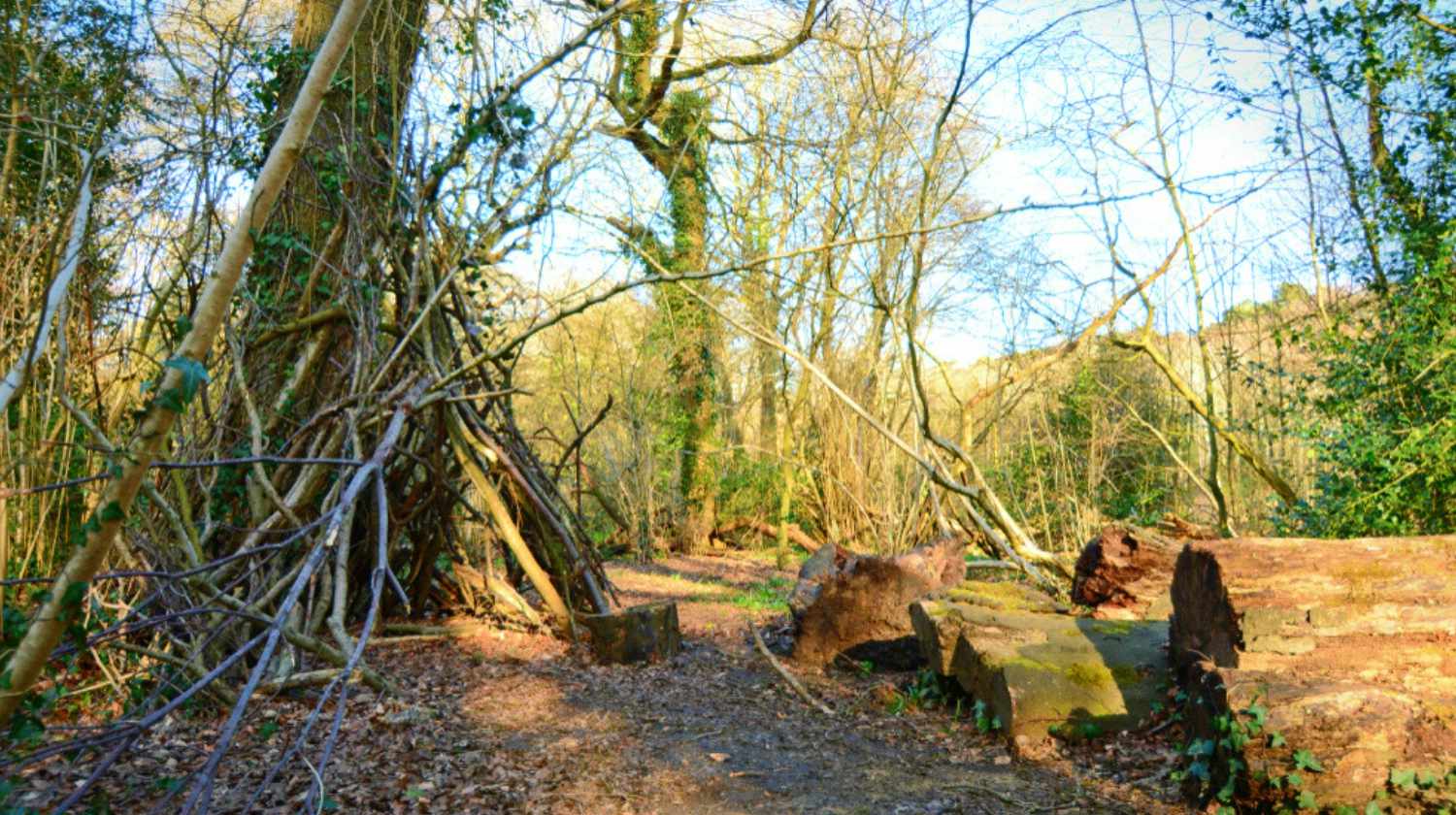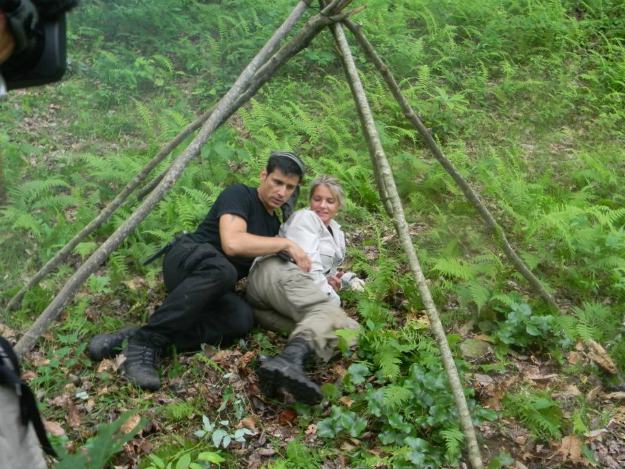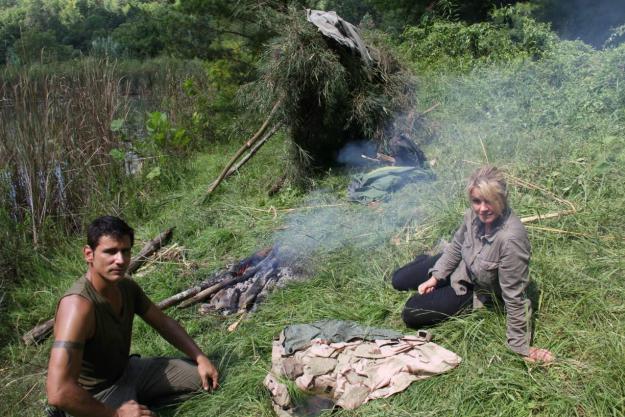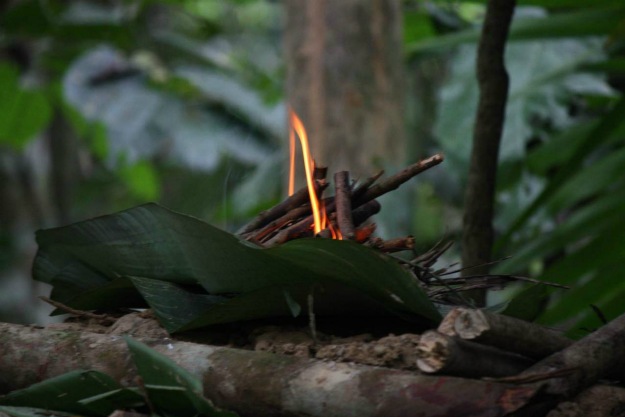Featured Articles
How To Build A Shelter Using Natural Resources

Knowing how to build a shelter is one of the most valuable skills when you’re stuck in the middle of nowhere.
RELATED: How To Build DIY Survival Shelters To Survive Through The Night
How to Build Survival Shelters with Materials Around You
Wilderness Survival Shelters
My first piece of advice on how to make a shelter from natural materials is to look around for something man-made.
In my last article, we talked about the use of a vehicle or vessel to keep us safe. But there are times when Mother Nature provides a hollow cave or natural covering.
This time around, I’m going to share some of the experiences I’ve had when Lady Luck is smiling down on someone else. There are times when we wish to build primitive shelters from scratch primarily with natural materials, but we aren’t always successful in foraging for these.
Unless you’re trained in thatching roofs, chances are your survival shelter is going to let water in when it rains. A plastic bag buried in your purse or pocket will go a long way towards providing a precious bit of waterproofing.
Building A Teepee
This lovely leaf teepee that we built in the Smoky Mountains looks to be the epitome of primitive shelter building yet hidden beneath its lush foliage is a trash bag covering the apex. Thankfully it didn’t rain but it was very comforting to know that if it did we would remain dry, even if it meant sitting upright and back to back.
As the weather turned out to be dry I sometimes wish we had lain down on the trash bag instead as were eaten alive by chiggers on this expedition. Hindsight is a wonderful thing.
In my experience, bindings made from roots or vines are rarely as robust as commercially manufactured strings, ropes, and cords. You may think that you don’t have anything like that with you, but take a look at your clothes.
Your clothing is your first line of defense in any survival situation and not just in the most literal sense — what are you wearing that you could adapt and use?
A little trick that Myke taught me is to replace my boot laces with 550 paracords and wrap a few extra lengths round for good measure. It’s a pain in the backside if you ever have to travel through airport security but a lifesaver out in the bush.
Even if you don’t have 550 cord, your regular shoelaces will work wonders in tying the struts of your shelter together. As will fabric strips ripped from the bottom of a shirt or skirt.
A single string of 550 cord cinched together with the top of this teepee in the Smokies. Always be sure to retrieve your cord, natural or otherwise, when you move on.
Another useful tip, though glaringly obvious, is making sure your shelter is big enough for you to fit into.
A single person can crunch into a remarkably small place, albeit with some discomfort, but if you’re making a temporary home for more than one person or your whole family it’s a good idea to test it out size wise. As a mother, I’m always thinking things like, “Would my little boy cope with this?
Would this type of shelter work if he was with us?”
This is Myke and I testing our shelter for size. Well, that’s my story and I’m sticking to it!
-

Building A Teepee Photo by Kotaksurat
Using A Poncho For Shelter
One of my absolute favorite items of clothing because its multi-faceted nature is the military poncho, yet I had never even heard of one before I met my husband. These days I carry one in my car, my camping kit, my survival bag and we have several other littered around the house that our boy plays in.
In addition to keeping you dry, a poncho has many potential uses in a survival situation; a rucksack, a raft, a tarp, a medical stretcher, and a smokehouse, to name but a few. And they make quick and awesome survival shelters.
You can string one up in whatever manner you fancy or if you don’t have enough cord to construct a ‘tent’ just lay one over any primitive shelter that you have made to act as extra waterproofing.
Here in Alaska, we strung one between two trees and then I filled the open sides with large leaves to help keep the heat in. When using a poncho in wet climes be sure to tie off the hood so you don’t get leaks.
Conversely, when it’s scorching prop the hood open so it acts as a vent.
There, of course, might be times when you do have next to nothing on you or with you that you can use and you have to create a shelter from what you have around you. My least favorite is the debris shelter, but sometimes there is no choice.
For those who don’t know, a debris shelter is created by basically scraping up old branches and leaves and piling them into a rudimentary shield against the elements.
We used one once when we were caught in a sudden tropical storm in Dominica. Itchy, uncomfortable and wet.
Using old branches and logs has obvious risks, other things are also likely to be using them as a home – sometimes stinging insects and arachnids but I have also seen lethal poison dart frogs in old logs in the Osa Peninsula in Costa Rica. I also once sat on a fer de lance in a fallen tree in the Peruvian Amazon.
This snake kills more people in South America than any other. Not what you want as a bedfellow.
RELATED: Conquering the Cornerstones: Shelter – the 1st Pillar of Survival
Building A Lean-to
Another basic shelter to make when you’re too exhausted to do anything else or perhaps when the light is fading is the ‘lean-to’. I was making this one on a Lost Survivors shoot for Travel Channel as the sun was going down in the Appalachians in Kentucky.
The main spine was an old tree trunk that had fallen and caught on another tree (not fallen to the ground) then I placed cut branches and leaves to form the back wall. It was another night on the forest floor, which is never ideal but the shelter is blocking a harsh wind that was kicking up.
On a separate trip to Kentucky, we wove a kind of cocoon out of river cane. We stuck either end of the canes into the ground to create a series of arches and then wove thinner more supple pieces of cane between the struts to make the walls.
You can use this technique with any kind of reed or wood that is pliable enough, willow for example.

Building A Lean-to Photo by Kotaksurat
In the close-up picture of me standing in front of it, you can see pretty flowers embedded in the walls. This wasn’t an attempt to create bucolic loveliness out in the wilds.
It’s an eye-saving mechanism, the cut cane was razor sharp and the flowers mark the dagger-like ends.

Ruth Englund Building A Lean-to Photo by Kotaksurat
It is without a doubt better to sleep up off the floor if you can. Even a layer of cut branches on the ground will insulate you from the cold.
Another very important reason to be up is so you don’t encounter creatures that could otherwise hurt or kill you. This is particularly true in tropical jungles and swamps.
My favorite shelter of all time was one at a beach in Aitutaki in the South Pacific. It was a platform protruding at one end from the top of some pandanus tree prop roots and supported at the other by tripods we made by lashing three sticks together.
The roof was a separate structure, a bit like a carport, crafted from palm leaves.
Building A Platform Shelter
Pandanus trees are great for shelter making, they look a little like palm trees but have these mangrove style prop roots. It’s the roots that are special, they are both sturdy and bendy.
We made the cross slats of the platform from these roots. Once they were covered in palm fronds, it was like sleeping in a bed.
They bounce a little when you lay down. Wonderful!
The mosquitoes in Aitutaki were bad, the noise was like the whirring of a cheap hairdryer. All night long.
However, the view in the morning made life a little easier to bear.

The first time I visited the Amazon rainforest we constructed a more elaborate version of the Aitutaki platform shelter. Unlike in our South Sea haven Amazonian land animals like to bite you, sting you and eat you.
Quick Tip: Bringing Fire Into Your Shelter
Getting off the ground is an essential, not a luxury.
Fire is also vital for protection in the deep jungle. Though our platform was too high to feed a fire without having to climb down, repeatedly, to the forest floor.
A problem exacerbated that we had our boots off at night to dry out our feet and prevent jungle rot.
Mike came up with the ingenious solution of having the fire in the shelter with us!

Quick Tip: Bringing Fire Into Your Shelter Photo by Kotaksurat
We built another mini wood platform on our sleeping platform. Afterward, we daubed a layer of thick clay on top of it to prevent the fire from burning through.
We had very few insect problems because it also acted as a smudge fire. A fair bit of the smoke was trapped in the shelter with us because of the roof.
We didn’t wake to the same amazing view as in Aitutaki. Thanks to our choice of shelter we made it through the night without becoming dinner for a jaguar.

Fire in the shelter Photo by Kotaksurat
Watch this video by J&J acres on how to build a teepee:
There is no blueprint for shelter building. Terrain and circumstance will dictate the final structure.
If I look back over the years and remember every single one that I’ve slept in, each one was different, each had its own set of quirks, foibles, discomforts, and itches. You rarely sleep well in a wilderness shelter but it’s always better to have one than not.
Do you trust in these methods of building a shelter? Share your thoughts in the comments section below!
UP NEXT:
- 3 Survival Shelters You Can Quickly Craft From Tree Branches
- Survival Shelters: Things You Need To Know
- Family Preparedness: What Are Your Survival Principles?
Editor’s Note: This post was originally published in February 2014 and has been updated for quality and relevancy.
-

 Do It Yourself7 months ago
Do It Yourself7 months agoParacord Projects | 36 Cool Paracord Ideas For Your Paracord Survival Projects
-

 Do It Yourself9 months ago
Do It Yourself9 months agoHow To Make Paracord Survival Bracelets | DIY Survival Prepping
-

 Do It Yourself9 months ago
Do It Yourself9 months ago21 Home Remedies For Toothache Pain Relief
-

 Do It Yourself10 months ago
Do It Yourself10 months agoSurvival DIY: How To Melt Aluminum Cans For Casting
-

 Exports8 months ago
Exports8 months agoAre Switchblades Legal? Knife Laws By State


Rachel Wells
February 3, 2014 at 9:21 AM
Once again, Ruthie provides us with ‘news we can use’! Each article is written well, easily understood and interesting to read – you can not help but learn and enjoy. Thank you so much Ruthie, not only for these wonderful series of articles but for taking the time to provide us the education that is ‘need to know’ – Keep up the great work..and may your future nights be ‘chigger’ free!
keeb
February 3, 2014 at 10:54 AM
as always-great articles & Pictures, love to learn what others have sucessfully done.
keeb.
Brig
February 3, 2014 at 11:27 AM
Nice start on the wikiup.
To weatherproof it (although sitting close, back to back may be nice), you must now thatch a covering over the leaves.
This takes some time, but you have lot’s of ferns there to use.
pick armfulls and then layer them around from bottom to top.
When you get to where your plastic bag will help, work that it also and over the ferns below it to shed the water.
Don’t skimp on the ferns either, the thicker they are the better.
This will make it warmer and more weather resistant.
My kids & I have camped in below 0 winter nice and warm in a shelter we built like this in the fall. Have camped at -40 in nice warm hemlock shelter (3′ thick bows). Then again, I grew up doing this kind of stuff for ‘fun’.
Love your articles, keep them up.
Robert Cowart
February 3, 2014 at 12:01 PM
Great article. Having been a scout leader for many years in the south chiggers ( some call them redbugs)can be a real problem. An old scouter told me to go to the drug store and purchase some sulphur flowers (powder form) and mix it 50-50 with talcum powder.when you get to your camping area shake some into the top of your socks and also under your belt around your waist. When they burrow into your skin they need to have something to push against. Chiggers and other bugs HATE sulphur. Good luck
Deez
February 3, 2014 at 8:08 PM
This reminded me of my childhood; out and about making ‘forts.’ Somehow my Dad always found us. Then he’d show us how to make it better. Thanks for reviving the memories AND providing a great tip about the fire on a platform. May need it here in the PNW where we do much camping. 🙂
Old Soldier
February 3, 2014 at 8:11 PM
Seldom mentioned in all these discussions are drainage. One way of sleeping warm is to build a fire on the ground under where your shelter will be and let the soil dry out and warm. Scrape the coals away and put up your shelter. Ditches around the edge will carry away the water that would otherwise run through your shelter. Every Boy Scout used to know to do this. All the enviormental tripe has just about caused this to become lost information.
Leighton Taylor
February 6, 2014 at 4:33 PM
As always, great article, Ruth! Awesome tips about using anything man-made you can find or what you have on your person to its full advantage. I really appreciate your writing!
Jordan Hall
February 7, 2014 at 7:01 AM
Great article Ms. England! Always great to watch your and Myke’s adventures. Keep up the good work.
Callum
February 7, 2014 at 1:49 PM
I always use a poncho
Aaron McAllister
February 8, 2014 at 9:15 PM
You might be able to skip a few more numbers, as you did between numbers 24 and 26 without your friend noticing it – you could skip a few more and maybe end on 110 or more and pray that he doesn’t notice the skips.
If the parachord breaks as when you are going down a steep cliff, you could use the broken pieces to secure a splint (or broken tree limb) to a broken leg (as in human limb) until you can get more professional help.
Emergency shoe repair by tying the ripped-off sole back on to the top of your shoe to ease walking on rough terrain.
Use strands to tie the poles and frame together to make a chaupah to use as a canopy for a wedding.
Use to patch a broken saddle strap to secure a saddle on a horse.
Use as kindling to start a fire by using sparks from a 9-volt battery and a Brillo or stainless steel scrubbing pad.
Use for marking your way into an unknown cave for shelter so that you could navigate your way back out even if darkness prevailed.
Use to restrain out-of-control persons until help arrives.
Tie it loosely around a young persons ankle and your wrist so that if he awakes during the night and tries to leave quietly you will be aroused, thereby keeping him from becoming lost in an unfamiliar territory.
Whiskey Sierra
February 10, 2014 at 10:15 PM
Ruth & Myke do a fair job of teaching survival techniques, but they often make the same mistake as some other instructors; they make things too complicated and miss the fundamentals. This shelter article is an example of primitive living skills and not basic survival. Over the years I’ve had to teach shelter building techniques to special operators, to kindergartners and all ages in between. To get a 5 year old to learn basic life saving skills, you need to teach them simple skills that will keep them alive till you find them. Using the basics from Hug-A-Tree, Lost-in-the-Woods, Find-a-Space-and-Show-Your-Face and The Rule of Threes, we’ve taught them to build simple beds that keep them off the ground and warm. In south Texas winters, with 40 degree rainy weather, we taught Cub Scouts to build debris shelters, but had them build their debris beds first and then debris shelters over them. They slept in those shelters without sleeping bags. Again, simple, small, quick, effective and warm. These procedures concentrate on what animals use to stay warm even in the worst weather. What works for mice works for ten year olds and works for adults too. That means prevent the worst kinds of body heat loss by using lots of insulation. A foot of leaves/needles prevents conductive heat loss to the ground, convective heat loss to the air and evaporative loss from any moisture in the debris layers. By adding a large garbage bag to this style shelter, you increase its effectiveness. This is true even in the summer time in the Smokey Mountains or in the fall in Florida. You don’t need teepees, lean to’s, thatched roofs or all those sophisticated structures that use up lots of your energy and time, precious commodities you need to conserve in a real survival situation. Keep your shelters simple but effective. Take care of your bodies needs in the right order and you’ll stay alive until you’re found and returned to your loved ones. Be Prepared!
Firemaker
February 24, 2014 at 1:47 PM
Whiskey Sierra checkout Ruth’s first article on shelter building where she covers the fundamentals. This article is second of 2
. http://www.survivallife.com/2014/01/24/bad-nights-and-easy-shelters/
Pingback: Surviving Obamanation » Survival Rules of Three – How Long Could You Last?
Pingback: Turning Your ATV Into a Survival Vehicle | Our Tyrannical Government
Pingback: Survival Rules of Three - How Long Could You Last? | Survival Life - Survival Life | Preppers | Survival Gear | Blog
Pingback: How To Make Homemade Survival Cement | My Emergency Preparedness Blog
Pingback: How To Make Homemade Survival Cement | Survival Life| Blog
Pingback: Create A Shelter Out of A Juniper Tree for Survival
Pingback: 3 Survival Shelters Made Out Of Tree Branches
Pingback: Top 30 ways of using plants and plant parts in your game Part 2 - Tribality
Pingback: 16 Long-Lost Survival Skills | SL
Pingback: 17 Old School Survival Skills You Should Know - Survive!
Pingback: 17 Old School Survival Skill That You Need To Know - Prepared Survivalist
Pingback: 3 Survival Shelters You Can Quickly Craft From Tree Branches - Survive!
Pingback: 3 Survival Shelters You Can Quickly Craft From Tree Branches - Survival Patch
Pingback: How To Build A Shelter Using Natural Resources - Survival Patch
Pingback: Emergency Shelter DIY | Basic Survival Skills - Survival Patch
Pingback: Emergency Shelter DIY | Basic Survival Skills - Survive!
Pingback: Snow Survival Shelter - Survive!
Pingback: Snow Survival Shelter | Primitive technology
Pingback: Native American Survival | What You Can Learn From These Experts
Pingback: Tarp Shelter: Survival Life Guide On Building Shelters | Survival Life
Pingback: 25 “Quick Up” Survival Shelters You Can Build With A Tarp | Primitive technology
Pingback: 25 “Quick Up” Survival Shelters You Can Build With A Tarp - Survival Patch
Pingback: 25 “Quick Up” Survival Shelters You Can Build With A Tarp - Survive!
Pingback: Introducing Frailejones: The Andes' Perfect Survival Plant | Survival Life
Pingback: 10 Ways to Use Paracord Bracelets to Save Your Life | Survival Life
Pingback: Plastic Bottles | Turning Garbage Into A Survival Tool | Survival Life
Pingback: Plastic Bottles | Uses That Can Save Your Life | Primitive technology
Pingback: Plastic Bottles | Uses That Can Save Your Life - Survival Patch
Pingback: Plastic Bottles | Uses That Can Save Your Life – Ultimate Survival Alerts
Pingback: Snow Survival Shelter | Withstanding The Cold Outdoors | Survival Life
Pingback: Snow Survival Shelter – Ultimate Survival Alerts
Pingback: Spider Shelter: Surviving the Wild Outdoors | A Survival Life Guide
Pingback: How To Make Homemade Survival Cement | Primitive technology
Pingback: How To Make Homemade Survival Cement
Pingback: How To Make Homemade Survival Cement - Survival Patch
Pingback: Couples Defense: What You Can Do With Your Partner To Stay Safe – Ultimate Survival Alerts
Pingback: Couples Defense: What You Can Do With Your Partner To Stay Safe
Pingback: Overnight Bushcraft Camp | How To Build A Bushcraft Camp | Survival Life
Pingback: Top 5 Survival Skills | Primitive technology
Jacob
July 16, 2021 at 1:34 AM
Amazing article Ms. England! Always great to watch your and Myke’s adventures and i realyy enjoy its. Keep up the good work. Thanks for sharing about the
shelters
Pingback: 11 Underrated Survival Skills You Should Know in the Urban Area - Survivalnomics
Pingback: 11 Underrated Survival Skills You Should Know in the Urban Area – Alive After USA Fall
Pingback: 11 Underrated City Survival Skills You Should Know in the Urban Area - Survivalnomics
Pingback: 11 Underrated City Survival Skills You Should Know in the Urban Area | Best Go Bag